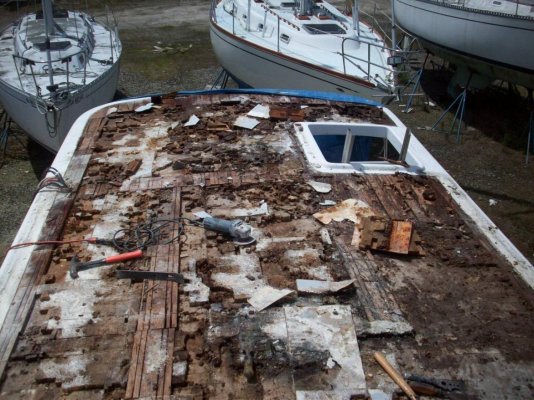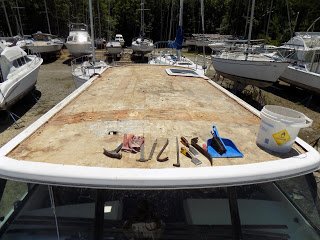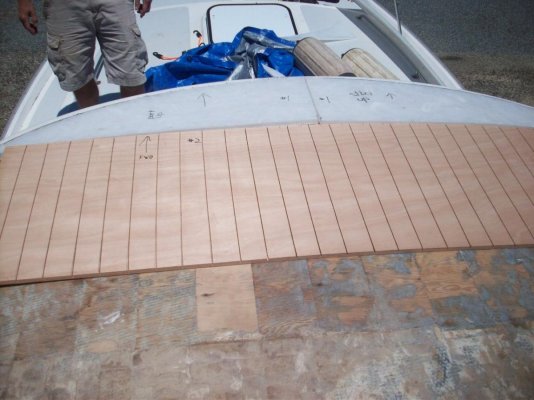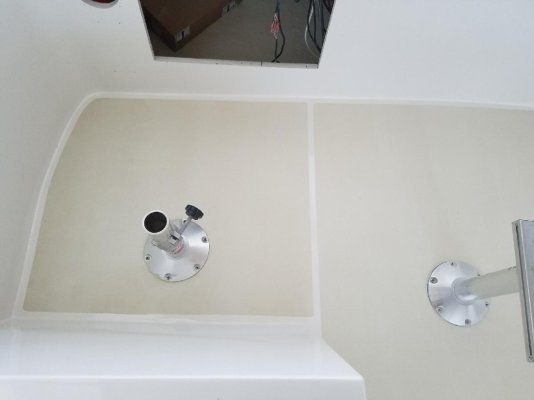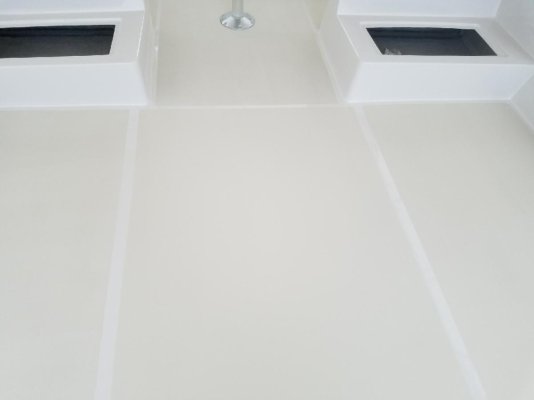SeaMoose
Senior Member
- Joined
- Oct 7, 2007
- Messages
- 360
- Vessel Name
- Sea Moose
- Vessel Make
- 1976 34' D/C Taiwanese Trawler
Hello All
A quick background - I've recored my decks, and most of the house already over the 17+ years I've owned this boat. So at the least I am a qualified amateur.
76 Marine Trader/CHB/Taiwanese Tub. Started peeing that ugly brown water off the back of the cabin top this season.
Once in the barn for the winter, cut the top layer of glass off right behind the seats and found the usual little blocks of luan the Asians loved back then, held together by polyester resin:

Of interest the top layer glass was 2 layers of 18 oz. cloth, with typical poor saturation, something plastic like - spray on truck liner maybe, and yet another 18oz layer cloth, maybe 2, clearly done with epoxy. Very heavy and zero adhesion between the original top and the truck liner I pulled the layers apart by hand! SMH what people do to "fix" things...
But I digress. This area was dry. Leaving a strip about 2' wide in place I opened up the back and sure enough it was rotted black biomass mush.

Bear in mind these are initial cuts to get the rotted goo out before winter I'll clean these to the edges before I start recoring.
To my surprise the bottom layer of the fiberglass sandwich is a paper thin layer of perhaps 6oz cloth, so thin and so fragile I've already poked a hole in it scraping the last of the rotted goo off.
Such poor construction doesn't surprise me at this point but it's still pretty pathetic. Under that is about a 2" air gap and the composite board that's the interior roof.
I'm inclined to take the whole thing out, put foam insulation boards in the air gap to insulate things, then recreate the bottom layer with two layers of 6 oz cloth, then a proper core of divinicell, or end grain balsa, followed by a solid layer on top (probably a 6 oz initial layer, followed by any needed leveling and 2 18oz layers.
Curious to hear from others who have done this job, how it was built, and how they recored it.
Specifically:
What construction method did you find?
Did you leave the paper thin bottom layer?
Did you cut the whole top off, or do it in sections. From what I can see if I cut the whole top off the house will collapse...
What did you recore with? I've used 3/4 Marine ply everywhere else but seems a little heavy to put on top. If three or four really heavy people want up there I'll tell them no
I expected to find a proper fiberglass sandwich not some cheesy paper thin bottom layer and an way overbuilt top layer. How they managed to make such a paper thin bottom layer on the ceiling - to support the weight of the luan blocks - that was a real trick. It's not chop gun glass which is what they used on the house exterior walls.
Thanks for reading. The boat's in the barn for the winter, and I'll resume in the Spring so lots of time to decide how to proceed.
And yes, yes, I know it's a waste of money to restore one of these things but it's too late now and I no longer care...
A quick background - I've recored my decks, and most of the house already over the 17+ years I've owned this boat. So at the least I am a qualified amateur.
76 Marine Trader/CHB/Taiwanese Tub. Started peeing that ugly brown water off the back of the cabin top this season.
Once in the barn for the winter, cut the top layer of glass off right behind the seats and found the usual little blocks of luan the Asians loved back then, held together by polyester resin:
Of interest the top layer glass was 2 layers of 18 oz. cloth, with typical poor saturation, something plastic like - spray on truck liner maybe, and yet another 18oz layer cloth, maybe 2, clearly done with epoxy. Very heavy and zero adhesion between the original top and the truck liner I pulled the layers apart by hand! SMH what people do to "fix" things...
But I digress. This area was dry. Leaving a strip about 2' wide in place I opened up the back and sure enough it was rotted black biomass mush.
Bear in mind these are initial cuts to get the rotted goo out before winter I'll clean these to the edges before I start recoring.
To my surprise the bottom layer of the fiberglass sandwich is a paper thin layer of perhaps 6oz cloth, so thin and so fragile I've already poked a hole in it scraping the last of the rotted goo off.
Such poor construction doesn't surprise me at this point but it's still pretty pathetic. Under that is about a 2" air gap and the composite board that's the interior roof.
I'm inclined to take the whole thing out, put foam insulation boards in the air gap to insulate things, then recreate the bottom layer with two layers of 6 oz cloth, then a proper core of divinicell, or end grain balsa, followed by a solid layer on top (probably a 6 oz initial layer, followed by any needed leveling and 2 18oz layers.
Curious to hear from others who have done this job, how it was built, and how they recored it.
Specifically:
What construction method did you find?
Did you leave the paper thin bottom layer?
Did you cut the whole top off, or do it in sections. From what I can see if I cut the whole top off the house will collapse...
What did you recore with? I've used 3/4 Marine ply everywhere else but seems a little heavy to put on top. If three or four really heavy people want up there I'll tell them no
I expected to find a proper fiberglass sandwich not some cheesy paper thin bottom layer and an way overbuilt top layer. How they managed to make such a paper thin bottom layer on the ceiling - to support the weight of the luan blocks - that was a real trick. It's not chop gun glass which is what they used on the house exterior walls.
Thanks for reading. The boat's in the barn for the winter, and I'll resume in the Spring so lots of time to decide how to proceed.
And yes, yes, I know it's a waste of money to restore one of these things but it's too late now and I no longer care...



